外研版(2019)必修第一册Unit 5 Into the wild Developing ideas Writing 课件(14张PPT)
文档属性
| 名称 | 外研版(2019)必修第一册Unit 5 Into the wild Developing ideas Writing 课件(14张PPT) | 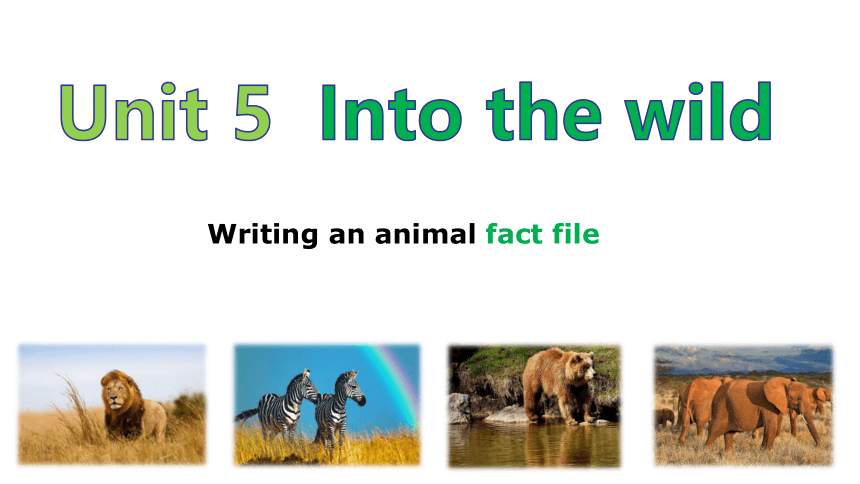 | |
| 格式 | pptx | ||
| 文件大小 | 5.7MB | ||
| 资源类型 | 教案 | ||
| 版本资源 | 外研版(2019) | ||
| 科目 | 英语 | ||
| 更新时间 | 2022-12-06 17:12:06 | ||
图片预览

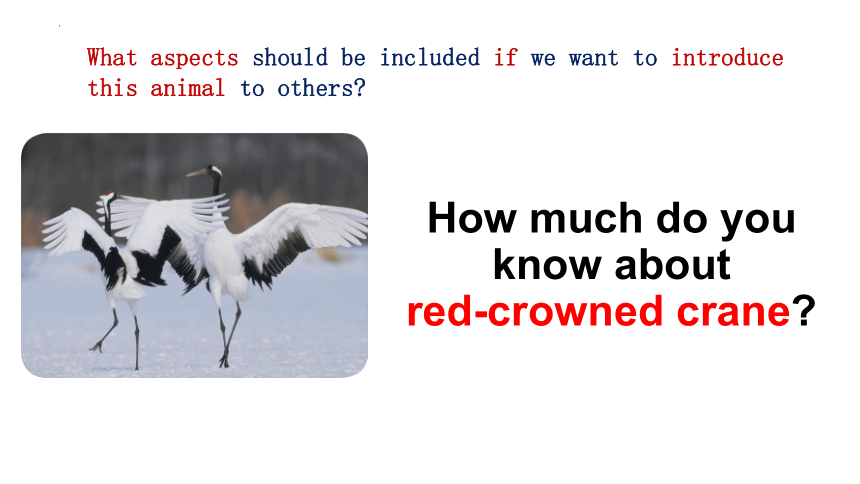
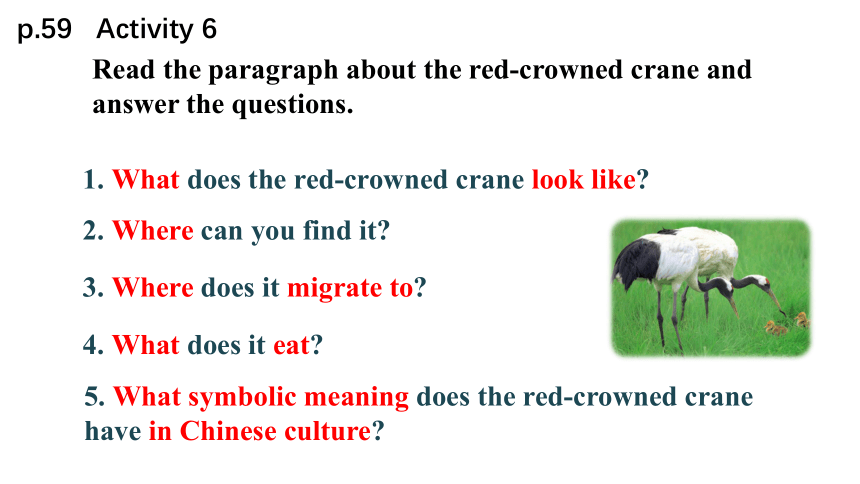

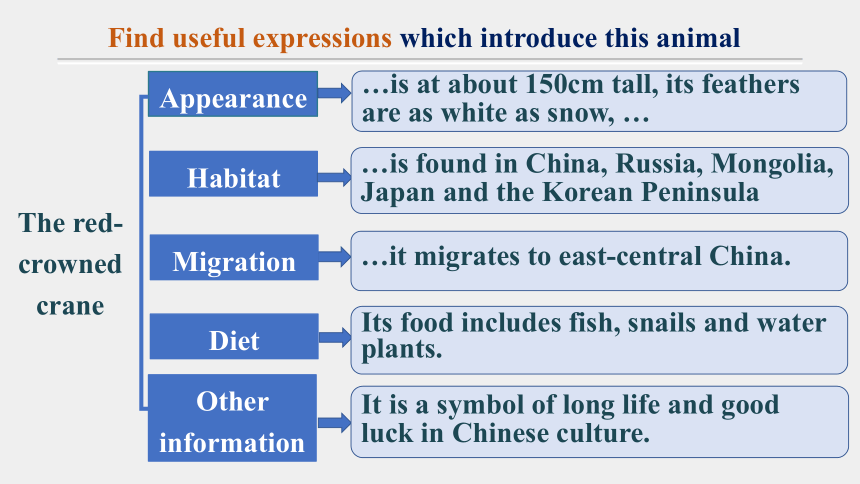

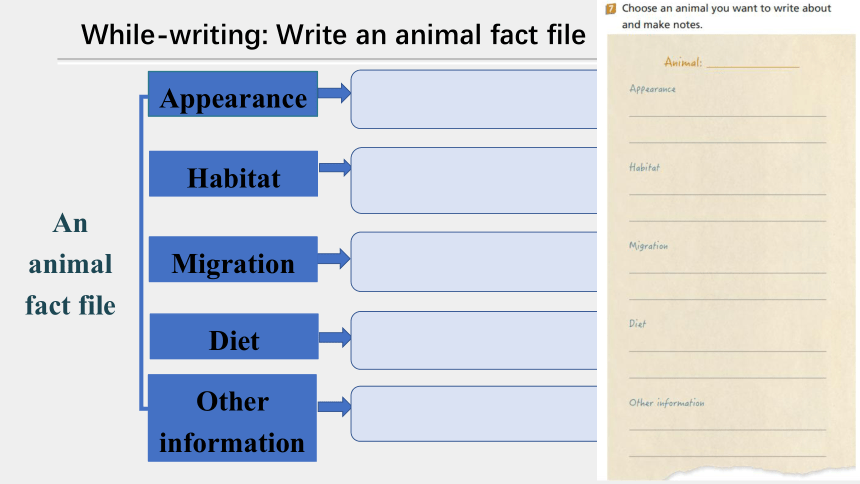
文档简介
(共14张PPT)
Unit 5 Into the wild
Writing an animal fact file
How much do you know about
red-crowned crane
What aspects should be included if we want to introduce this animal to others
p.59 Activity 6
Read the paragraph about the red-crowned crane and answer the questions.
1. What does the red-crowned crane look like
2. Where can you find it
3. Where does it migrate to
4. What does it eat
5. What symbolic meaning does the red-crowned crane have in Chinese culture
p.59 Activity 6
1. What does the red-crowned crane look like
2. Where can you find it
3. Where does it migrate to
4. What does it eat
5. What symbolic meaning does the red-crowned crane have in Chinese culture
It has white feathers except for some black ones on its face, neck and wings.
It also has bright red skin on the top of its head.
It can be found in China, Russia, Mongolia, Japan and the Korean Peninsula.
It migrates to east-central China when the weather gets cold.
It eats fish, snails and water plants.
It has a symbolic meaning of long life and good luck in Chinese culture.
Appearance
Habitat
The red-crowned crane
…is at about 150cm tall, its feathers are as white as snow, …
…is found in China, Russia, Mongolia, Japan and the Korean Peninsula
…it migrates to east-central China.
Its food includes fish, snails and water plants.
It is a symbol of long life and good luck in Chinese culture.
Migration
Diet
Other information
Find useful expressions which introduce this animal
它有……高。
它的名字来自……
它独有的特征是……
它的食物包括……
它是……的象征。
It is …tall.
It gets its name from…
Its unique feature is…
Its food includes…
It is a symbol of…
Pre-writing: Useful expressions
While-writing: Write an animal fact file
Appearance
Habitat
An animal fact file
Migration
Diet
Other information
While-writing: Write an animal fact file, use the notes.
Appearance:
thin and long legs,
snowy white feathers,
about 140 cm in height,
weigh up to 32 kilograms, ...
Habitat:
different/various places,
is found in East Asia,
desert, forests, grasslands,
warm and humid bushes…
Migration:
They migrate to China in winter.
When it becomes warm,
it migrates to Siberia.
Diet/Food:
have a good appetite,
various grains, leaves,
water plants, insects, fish…
Other information:
It is a symbol of ….It stands for…
Share your animal fact file with the class.
Post-writing: Presentation
Post-writing: an animal fact file— the Siberian crane
The Siberian crane is also known as the snow crane. It is about 140 cm in height, generally shorter than the red-crowned crane. Its feathers are nearly all snowy white except for some black ones that are only visible in flight. Its featherless face is reddish in colour.
Appearance
The Siberian crane is usually found in East Asia, where its numbers are known as the eastern populations. These migrate to China in winter. Other much smaller populations migrate to Iran in winter.
Post-writing: an animal fact file— the Siberian crane
Habitat & Migration
The snow crane has a good and diverse appetite, including fish, insects, the roots and tubers of water plants and so on.
Post-writing: an animal fact file— the Siberian crane
Diet
the short thick round part of an underground stem or root of some plants, such as potatoes, which stores food and from which new plants grow
块茎(某些植物的肉质地下茎)
In Chinese culture, the snow crane is a symbol of elegance, purity, good fortune and long life.
Post-writing: an animal fact file— the Siberian crane
Other information
Self-evaluation and Peer-evaluation
Checklist Your evaluation
layout (appearance/habitat/migration/diet/other information) ☆☆☆☆☆
language (tense; voice; beautiful sentences) ☆☆☆☆☆
handwriting ☆☆☆☆☆
TOTAL MARK
Unit 5 Into the wild
Writing an animal fact file
How much do you know about
red-crowned crane
What aspects should be included if we want to introduce this animal to others
p.59 Activity 6
Read the paragraph about the red-crowned crane and answer the questions.
1. What does the red-crowned crane look like
2. Where can you find it
3. Where does it migrate to
4. What does it eat
5. What symbolic meaning does the red-crowned crane have in Chinese culture
p.59 Activity 6
1. What does the red-crowned crane look like
2. Where can you find it
3. Where does it migrate to
4. What does it eat
5. What symbolic meaning does the red-crowned crane have in Chinese culture
It has white feathers except for some black ones on its face, neck and wings.
It also has bright red skin on the top of its head.
It can be found in China, Russia, Mongolia, Japan and the Korean Peninsula.
It migrates to east-central China when the weather gets cold.
It eats fish, snails and water plants.
It has a symbolic meaning of long life and good luck in Chinese culture.
Appearance
Habitat
The red-crowned crane
…is at about 150cm tall, its feathers are as white as snow, …
…is found in China, Russia, Mongolia, Japan and the Korean Peninsula
…it migrates to east-central China.
Its food includes fish, snails and water plants.
It is a symbol of long life and good luck in Chinese culture.
Migration
Diet
Other information
Find useful expressions which introduce this animal
它有……高。
它的名字来自……
它独有的特征是……
它的食物包括……
它是……的象征。
It is …tall.
It gets its name from…
Its unique feature is…
Its food includes…
It is a symbol of…
Pre-writing: Useful expressions
While-writing: Write an animal fact file
Appearance
Habitat
An animal fact file
Migration
Diet
Other information
While-writing: Write an animal fact file, use the notes.
Appearance:
thin and long legs,
snowy white feathers,
about 140 cm in height,
weigh up to 32 kilograms, ...
Habitat:
different/various places,
is found in East Asia,
desert, forests, grasslands,
warm and humid bushes…
Migration:
They migrate to China in winter.
When it becomes warm,
it migrates to Siberia.
Diet/Food:
have a good appetite,
various grains, leaves,
water plants, insects, fish…
Other information:
It is a symbol of ….It stands for…
Share your animal fact file with the class.
Post-writing: Presentation
Post-writing: an animal fact file— the Siberian crane
The Siberian crane is also known as the snow crane. It is about 140 cm in height, generally shorter than the red-crowned crane. Its feathers are nearly all snowy white except for some black ones that are only visible in flight. Its featherless face is reddish in colour.
Appearance
The Siberian crane is usually found in East Asia, where its numbers are known as the eastern populations. These migrate to China in winter. Other much smaller populations migrate to Iran in winter.
Post-writing: an animal fact file— the Siberian crane
Habitat & Migration
The snow crane has a good and diverse appetite, including fish, insects, the roots and tubers of water plants and so on.
Post-writing: an animal fact file— the Siberian crane
Diet
the short thick round part of an underground stem or root of some plants, such as potatoes, which stores food and from which new plants grow
块茎(某些植物的肉质地下茎)
In Chinese culture, the snow crane is a symbol of elegance, purity, good fortune and long life.
Post-writing: an animal fact file— the Siberian crane
Other information
Self-evaluation and Peer-evaluation
Checklist Your evaluation
layout (appearance/habitat/migration/diet/other information) ☆☆☆☆☆
language (tense; voice; beautiful sentences) ☆☆☆☆☆
handwriting ☆☆☆☆☆
TOTAL MARK
